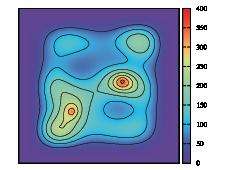A good guessing method makes supercomputing more efficient

In his doctoral dissertation, Kurt Baarman, a researcher from Aalto University, developed methods for making electron density calculations more efficient. These methods can also be applied to pharmaceutical development.
A computer is an increasingly important tool for both physicists and chemists. Computational physics can be used to model materials that cannot yet be produced experimentally. Even the electronic structure surrounding an atom can be determined with numerical methods. These nonlinear computational problems, however, come with a particular difficulty: the solution has to be guessed in advance.
"Only then we can see how good our guess was. In my dissertation, I have looked at ways to minimise the number of guesses needed to achieve the best possible result", Kurt Baarman explains.
With the help of supercomputers and computational methods, the interactions between hundreds of molecules can be modelled. This has aroused interest in the pharmaceutical companies, electronics industry and developers of new materials, because the electronic structure of a material determines its essential electric and chemical properties. Computational speed is of essence because a large part of the supercomputer capacity in the world is used on calculating the electronic structure of materials.
In his dissertation, Baarman developed new methods for making electron density calculations more efficient. The first research paper in the dissertation demonstrates how quasi-Newton methods, which have been long known to mathematicians, can be applied to calculations of materials' electronic structures using the density functional theory.
Earning the 1998 Nobel Prize in Chemistry to its inventor, density functional theory has become the most popular model for calculating the electronic structure of materials. "Based on the results, when applied correctly, quasi-Newton is a very good method. For more complex problems it comes up with a solution more effectively than other methods. "
Medicines and new materials
The other important innovation to come from the dissertation is a novel update operator, which speeds up iterative electronic structure calculations.
"It shortens the computational times required. Now we are able to perform calculations on more challenging systems", Baarman states.
Baarman's methods work particularly well with computationally challenging materials, such as metals.
At the moment, the researcher from the Aalto University Department of Mathematics and Systems Analysis is visiting the biomolecular research group of the Fritz Haber Institute in Berlin where he is implementing the computational methods for the code developed and used by the physicists of the group.
"It makes the physicists' job easier. They are interested in what a molecule looks like, its formation energy or how a drug reacts with another molecule, not in constructing a computational method."
Baarman hopes that in the future, the methods now being tested by chemists and physicists will be in wider use.
"The next step is for product developers to start using the tools, developing new medicines, materials or for instance catalytic converters for cars."
Provided by Aalto University



















